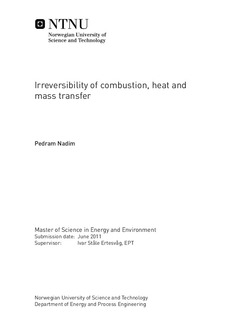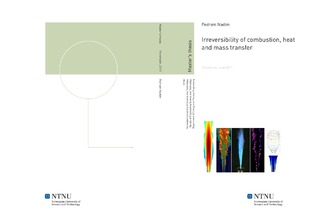| dc.contributor.advisor | Ertesvåg, Ivar Ståle | nb_NO |
| dc.contributor.author | Nadim, Pedram | nb_NO |
| dc.date.accessioned | 2014-12-19T11:46:47Z | |
| dc.date.available | 2014-12-19T11:46:47Z | |
| dc.date.created | 2011-09-15 | nb_NO |
| dc.date.issued | 2011 | nb_NO |
| dc.identifier | 441349 | nb_NO |
| dc.identifier | ntnudaim:6246 | nb_NO |
| dc.identifier.uri | http://hdl.handle.net/11250/234381 | |
| dc.description.abstract | Combustion is by far the most commonly used technology for energy conversion. The analysis of entropy generation and exergy loss is normally used to optimize thermal energy technologies such as gas turbines. The loss of exergy in the combustor is the largest of all component losses in gas turbine systems. The exergy efficiency of gas turbine combustors is typically 20-30%. In recent years the focus on reduction of climate gas and pollutant emissions from combustion has been a driving factor for research on combustion efficiency. The emphasis on fuel economy and pollution reduction from combustion motivates a study of the exergy efficiency of a combustion process. A bulk exergy analysis of the combustor does not take into account the complexity of the combustion process. The spatial dimensions of the flame must be accounted for in order gain detailed information about the entropy generation. This motivates a study of the local entropy production in a flame and quantifying the mechanisms that reduce the exergetic efficiency. The entropy production in combustion is also believed to have an effect on the stability of the flame. As most combustors operate with turbulent flow the emphasis of this report is on turbulent combustion.The source of exergy destruction or irreversibility in combustion is generally attributed to four different mechanisms: chemical reaction, internal heat transfer, mass diffusion of species, and viscous dissipation. The irreversibilities from the first three sources have been computed for a turbulent hydrogen H2 jet diffusion flame using prescribed probability density functions and data from experiments. The contribution of each source of exergy destruction is locally quantifed in the flame. Two different modeling assumptions are made, one based on a fast chemistry assumption and the other based on curve fitted relations from experimental data. The second law efficiency of the flame was found to be 98.7% when assuming fast chemistry, and 76.0% when curve fits from experimental data where used.The contribution from viscous dissipation has in previous studies been found to be negligible, and in order to simplify the modeling of the turbulent flow its contribution to the total entropy production has not been studied in this report. | nb_NO |
| dc.language | eng | nb_NO |
| dc.publisher | Institutt for energi- og prosessteknikk | nb_NO |
| dc.subject | ntnudaim:6246 | no_NO |
| dc.subject | MTENERG energi og miljø | no_NO |
| dc.subject | Varme- og energiprosesser | no_NO |
| dc.title | Irreversibility of combustion, heat and mass transfer | nb_NO |
| dc.type | Master thesis | nb_NO |
| dc.source.pagenumber | 90 | nb_NO |
| dc.contributor.department | Norges teknisk-naturvitenskapelige universitet, Fakultet for ingeniørvitenskap og teknologi, Institutt for energi- og prosessteknikk | nb_NO |

